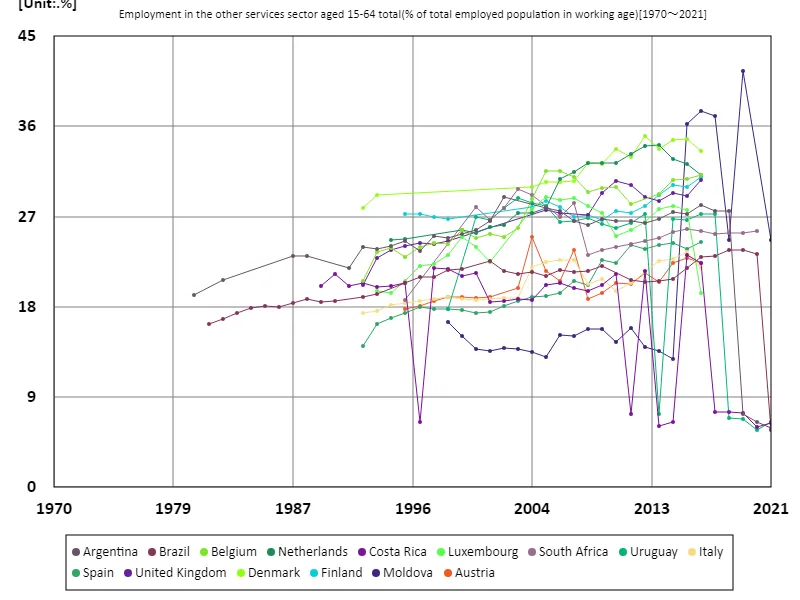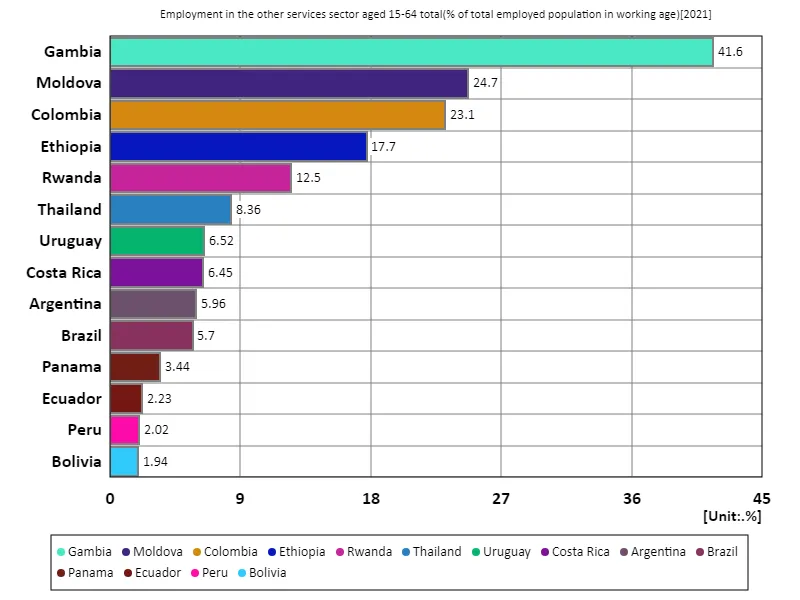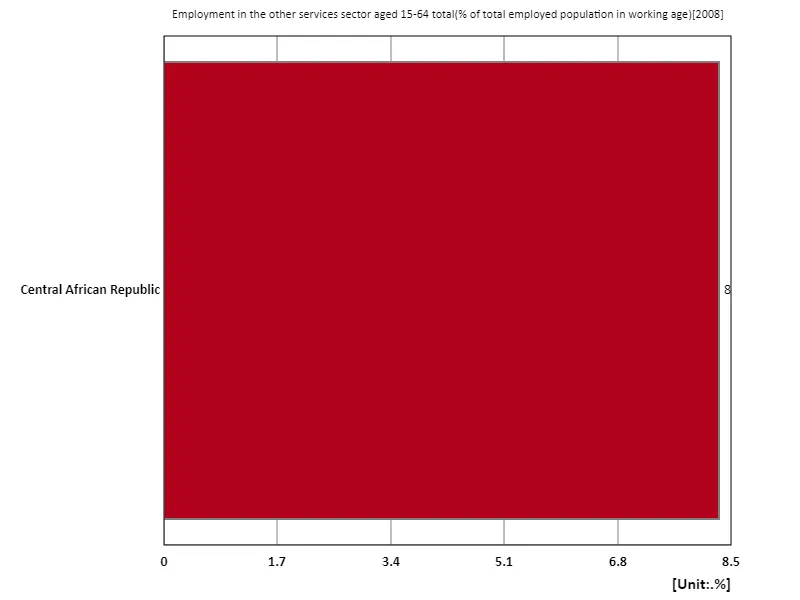- Abstract
- Employment rate for all 15-64 year olds and other service sectors (percentage of working age working population)
- Employment rate for all 15-64 year olds and other service sectors (percentage of working age working population) (Worldwide)
- Employment rate for 15-64 year olds overall, other services sector (percentage of working age working population) (Worldwide, latest year)
- Employment rate for 15-64 year olds overall, other services sector (percentage of working age employed) (region, latest year)
- Reference
Abstract
Uruguay’s other services sector employment rate of 6.52% in 2021 reflects differences in economic activity across regions and countries. The sector demonstrates the diversity and breadth of employment as it includes a wide range of services such as education, health care and public administration. Uruguay has a stable economy and a high standard of living, and its comprehensive public services are contributing to increased employment. Over the past few decades, service sector employment has been on the rise globally, especially in developed countries. This is due to the rise in knowledge-intensive jobs as the country shifts from manufacturing to services. Uruguay’s high employment rate suggests that the country recognizes the importance of its services sector and is strengthening related policies.
Employment rate for all 15-64 year olds and other service sectors (percentage of working age working population)
Employment in the other services sector in Denmark between 1980 and 2021 has undergone considerable change, from a low in the 1980s to a peak of 35.1% in 2012. The surge reflects a shift in Denmark’s labour market from manufacturing to services. The high employment rate in the service sector is due to the expansion of public services, education, medical care, etc., as well as the development of a knowledge-based economy. However, the 95.8% fall from the peak suggests slower growth in the services sector and increased employment opportunities in other sectors. In particular, with digitalisation and globalisation on the rise, the overall job market is diversifying and there is growth not only in the service sector but also in other areas. The Danish example shows the dynamics of employment in response to changes in the economic structure, and indicates that the balance between the service sector and other sectors will continue to be important in the future.


The maximum is 35.1%[2012] of Denmark, and the current value is about 95.8%
Employment rate for all 15-64 year olds and other service sectors (percentage of working age working population) (Worldwide)
Employment in the other services sector in Moldova from 1980 to 2021 has shown notable growth. In particular, the current data of 59.5% after a peak of 41.6% in 2019 indicates a rapid expansion of the country’s services sector. This increase in Moldova is due to economic changes both domestically and internationally, as well as an increasing demand for services. In the past few decades, Moldova has experienced a structural transformation of its economy, with a shift away from agriculture towards services. This has led to increased employment in sectors such as education, health care and public services. In particular, Moldova’s economic growth has led to increased urbanization and industrialization, which has led to an increase in employment opportunities in the service sector, which has contributed to the increase in employment rate. Foreign influences and deepening economic ties with the EU are also boosting growth in the services sector. This trend reflects the growing importance of the services sector as Moldova moves to diversify its economy. The future will require more sustainable growth, in balance with other sectors of the economy.


The maximum is 41.6%[2019] of Moldova, and the current value is about 59.5%
Employment rate for 15-64 year olds overall, other services sector (percentage of working age working population) (Worldwide, latest year)
In 2021 data, Gambia recorded the highest employment rate in the other services sector at 41.6%, compared to an overall average of 11.6% and a total of 162%. The Gambia’s high employment rate reflects the country’s very active service sector, which is likely due to the expansion of public services, education and healthcare. In particular, in developing countries like The Gambia, the service sector tends to be an important source of employment. The overall average of 11.6% suggests that other countries have smaller or less diversified service sector employment. The 162% total figure may include multiple economic indicators and data and may reflect the intersection of multiple sectors. The data shows that service sector employment is diverse globally, with significant differences depending on the economic situation and development of different regions. In the future, we expect further development of the service industry as well as changes in each country’s economic structure.


The maximum is 41.6% of Gambia, the average is 11.6%, and the total is 162%
Employment rate for 15-64 year olds overall, other services sector (percentage of working age employed) (region, latest year)
According to 2008 data, the employment rate for all 15-64 year olds in the service sector and other services sector was highest in the Central African Republic at 8.31%, while the overall average and total were also 8.31%. The data shows that the service sector in the Central African Republic has a relatively high employment rate, in line with other countries. Data for this period reflect the uneven distribution of the services sector around the world, with its proportions tending to be lower in developing countries in particular. The high employment rate in the Central African Republic may be due to the role of the service sector in the country’s characteristics and economic structure, but overall levels are still often low. In developing countries, the development of the service sector has lagged behind other industries, which is thought to be due in particular to the underdevelopment of public services and basic infrastructure. In the future, as the economy develops, the employment rate in the service sector is expected to increase. In particular, as the economy grows, the service industry will play a key role as a source of employment, and developments will likely vary depending on the economic situation and policies of each region.


The maximum is 8.31% of Central African Republic, the average is 8.31%, and the total is 8.31%


Comments